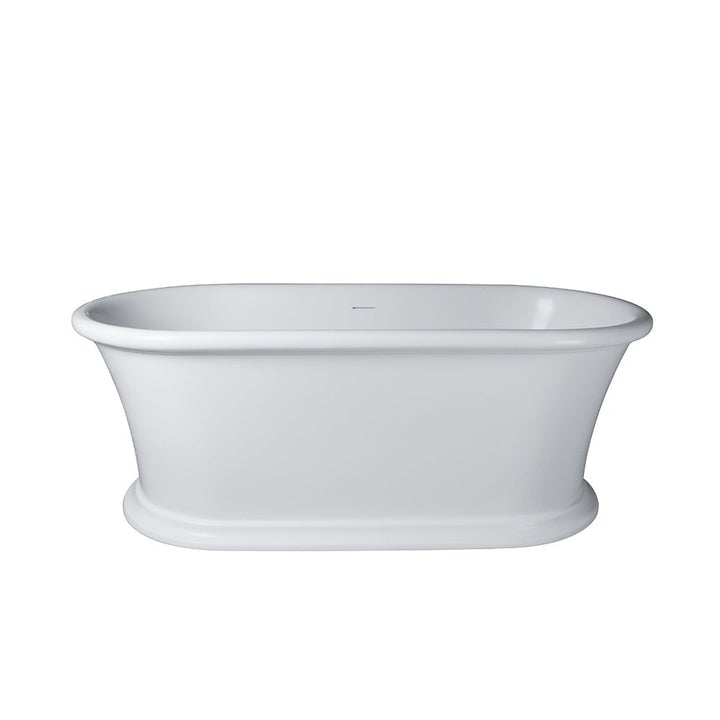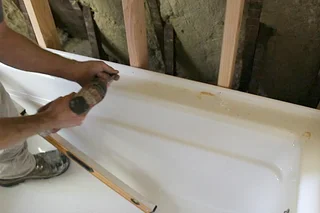Just about every person seems to have their own thinking with regards to Installing A Bathtub.

Mounting a bathtub isn't precisely brain surgery, however it does call for solid plumbing, woodworking, and often, tiling abilities. Replacing an old tub with a brand-new one is also a reasonably challenging task. If the old tub is easily available, the project can move speedily; if you have to open up a wall surface to remove the old bathtub and also position the brand-new tub, the job is a lot harder. In either instance, the task is within a home handyman's abilities, although you will certainly need a helper to leave the old bathtub and set in the brand-new one. See to it you have certified yourself for the task and also fit attempting it. As opposed to hiring a specialist to take control of a halfway-completed task, it is better to think about using one prior to you begin. Possibilities are you may require a specialist plumber to make tube links.
This article will assist you mount a brand-new bath tub in your shower room if you have actually currently acquired a new tub as well as don't require to alter the plan of your previous water pipelines.
Your devices and material checklist ought to make up the following:
Removing Old Touches
If you require to change old faucets with brand-new ones as a part of your installation, after that the first thing you must do is detach the water. After doing so, switch on the taps to drain any kind of water continuing to be in the system. The procedure of getting rid of the existing faucets can be fairly bothersome as a result of the limited gain access to that is commonly the situation.
Utilize a container wrench (crowsfoot spanner) or a tap tool to undo the nut that attaches the supply pipelines to the faucets. Have a fabric prepared for the staying water that will come from the pipelines. As soon as the supply pipelines have been eliminated, make use of the very same tool to loosen the nut that holds the taps onto the bath/basin. You will require to quit the single taps from transforming throughout this process. Once the taps have actually been gotten rid of, the holes in the bath/basin will certainly have to be cleansed of any kind of old securing compound.
Before moving on to fit the brand-new faucets, compare the pipe links on the old faucets to the brand-new taps. If the old faucets are longer than the brand-new taps, then a shank adapter is needed for the brand-new taps to fit.
Suitable New Taps
If the tails of the new taps are plastic, after that you will certainly require a plastic port to prevent damage to the thread. One end of the adapter fits on the plastic tail of the faucet as well as the other end provides a link to the current supply pipelines.
If you need to fit a monobloc, then you will call for minimizing couplers, which connects the 10mm pipe of the monobloc to the standard 15mm supply pipeline.
Next off, position the tap in the installing hole in the bath/basin making certain that the washing machines are in area between the tap and also the sink. Protect the tap in position with the maker offered backnut. Once the faucet is securely in place, the supply pipelines can be linked to the tails of the taps. The taps can either be connected by utilizing corrugated copper piping or with typical tap adapters. The previous type needs to be linked to the tap finishes first, tightening up only by hand. The supply pipes can later on be linked to the various other end. Tighten both ends with a spanner after both ends have actually been linked.
Installing the Tub
Using both wooden boards under its feet, put the bathtub in the needed placement. The wooden boards are helpful in uniformly spreading out the weight of the bathtub over the location of the boards instead of concentrating all the weight onto four little points.
The next objective is to guarantee that the bath tub is leveled all round. This can be achieved by checking the level as well as readjusting the feet on the bathtub up until the level reviews level.
To set up faucets, fit the bottom of the outermost flexible tap port to the appropriate supply pipe by making a compression sign up with; after that do the same for the various other faucet.
Switch on the water system and also check all joints and also brand-new pipework for leaks as well as tighten them if essential. Fill the tub as well as also check the overflow electrical outlet and also the regular outlet for leakages.
Ultimately, fix the bath paneling as explained in the supplier's instruction manual. Tiling as well as securing around the bath tub needs to wait until the bathtub has been utilized at the very least once as this will settle it right into its last placement.
Preparing for the Installation
Firstly, the sustaining structure provided with the bath should be fitted (if required) according to the producer's directions. Next off, fit the faucets or mixer to the bath tub. When suitable the tap block, it is essential to ensure that if the tap includes a plastic washer, it is fitted in between the bathroom and also the faucets. On a plastic bathroom, it is additionally sensible to fit a supporting plate under the taps unit to prevent strain on the bathtub.
Fit the flexible faucet connectors to the bottom of the two taps using 2 nuts and olives (in some cases supplied with the tub). Fit the plug-hole outlet by smearing mastic filler round the sink outlet opening, and afterwards pass the electrical outlet via the hole in the bathroom. Utilize the nut provided by the maker to fit the plug-hole. Take a look at the plug-hole electrical outlet for an inlet on the side for the overflow pipeline.
Next, fit the end of the versatile overflow pipe to the overflow outlet. Afterwards, screw the pipeline to the overflow face which must be fitted inside the bathroom. Make certain you utilize every one of the supplied washers.
Connect the catch to the bottom of the waste electrical outlet on the bath tub by winding the string of the waste outlet with silicone mastic or PTFE tape, and screw on the trap to the electrical outlet. Link the bottom of the overflow tube in a similar manner.The bath should currently prepare to be suited its final position.
Tiling Around the Bath tub
In the location where the bathroom satisfies the ceramic tile, it is essential to secure the joins with a silicone rubber caulking. This is essential as the fitting can relocate enough to fracture a stiff seal, triggering the water to penetrate the wall surface in between the bath and also the tiling, causing problems with wetness as well as possible leaks to the ceiling listed below.
You can select from a variety of coloured sealers to assimilate your fixtures and also fittings. They are marketed in tubes and also cartridges, as well as are capable of securing voids as much as a width of 3mm (1/8 inch). If you have a bigger void to load, you can load it with spins of soaked newspaper or soft rope. Remember to always fill the bath tub with water prior to securing, to enable the movement experienced when the tub remains in usage. The sealer can break relatively very early if you do not consider this motion before sealing.
Alternatively, ceramic coving or quadrant floor tiles can be made use of to border the bath or shower tray. Plastic strips of coving, which are easy to use and also cut to dimension, are also conveniently offered on the marketplace. It is a good idea to fit the ceramic tiles using waterproof or waterproof glue and cement.
Bathtub Installation
How Important Is A Bathtub To Your Home?
High-quality baths, showers, and other bathroom updates are necessary when considering a smart investment in your home. It’s a room that you go to every day and one that is constantly being used by guests.The bathroom is one of the top trafficked rooms in a home and also one of the most valuable in terms of home resale.
Install Piping Before Tub
You will be using your existing drain and waste vent system, but pipes required include the hot and cold water supply lines and a pipe leading to a shower head. A mixing valve and shower head are also needed. Air chambers may be required.
Position the Tub
Lower the tub into place so that the continuous flange fits against the wall studs and rests on 1’x4' or 2’x4' supports. Anchor the tub to the enclosure with nails or screws inserted through the flanges into the studs.
NOTE: Remember, bathtubs and shower stalls may require support framing. A bathtub filled with water is extremely heavy, so check building codes and framing support before installing the tub.
Assemble Drain Connections
Assemble the bathtub drain connections by connecting the tub overflow with the tub drain above the trap, not beyond it. The trap will have a compression fitting that screws over the arm of the overflow assembly.
Place a Pipe For the Shower Head
First, locate a brass female threaded winged fitting and attach it to a framing support via a screw or a nail. Then run a pipe up the wall for the shower head. Sweat or solder the other side of the brass fitting to the top of the pipe.
Attaching Hot and Cold Water Lines
Attach your water lines for both hot and cold by sweating these directly into the hot and cold ports of the mixing valve. The mixing valve will be how water enters the tub’s system, not by the pipes themselves.
Install the Spout
Extend a piece of 1/2 inch pipe, or whichever length is specified in the manufacturer’s instructions, for the tub spout. Sweat on a male threaded fitting at the end of the pipe or use a brass nipple of the proper length and a 1/2 inch cap.
NOTE: At this point you should have your rough-in plumbing work inspected before proceeding further.
Check For Leaks
Restore the water pressure and check the drain connection and the supply pipes for any sign of leaking.
estore the Bathroom Wall
Replace the wall with moisture-resistant drywall as a base for your wall covering. Seal the joints between the wall and your new tub with silicone caulk as protection against water seepage.
https://www.berkeys.com/2016/12/02/bathtub-installation-dallas/

Do you appreciate reading up on How to Install a Bathtub? Try to leave a comment down below. We would be glad to listen to your ideas about this entry. Hoping that you come back again in the future. Sharing is good. Helping others is fun. Thanks for your time. Please come by our blog back soon.
Or Book Technician Here